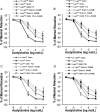Bariatric surgery reduces visceral adipose inflammation and improves endothelial function in type 2 diabetic mice
- PMID: 21680898
- PMCID: PMC3158262
- DOI: 10.1161/ATVBAHA.111.225870
Bariatric surgery reduces visceral adipose inflammation and improves endothelial function in type 2 diabetic mice
Abstract
Objective: Bariatric surgery is emerging as an effective method to alleviate a multitude of medical conditions associated with morbid obesity and type 2 diabetes. However, little is known about the effects and mechanisms of bariatric surgery on visceral fat inflammation and endothelial dysfunction in type 2 diabetes. We hypothesize that bariatric surgery ameliorates interferon-γ-mediated adipose tissue inflammation/oxidative stress and improves endothelial function in type 2 diabetic mice.
Methods and results: Control mice (m Lepr(db)) and diabetic mice (Lepr(db)) were treated with either sham surgery or improved gastric bypass surgery and then were evaluated at 5, 10, 20, and 30 days to assess postsurgical effects. Surgery reduced body weight, abdominal adiposity, blood glucose level, and food intake in Lepr(db). The surgery-induced decrease in visceral adiposity was accompanied by amelioration of T-lymphocytes and macrophage infiltration, as well as reduction in the expression of interferon-γ and other inflammatory cytokines in the mesenteric adipose tissue (MAT) of Lepr(db) mice. Furthermore, surgery improved endothelium-dependent, but not endothelium-independent, vasorelaxation in small mesenteric arteries (SMA) of Lepr(db) mice. The improvement in endothelial function was largely attenuated by nitric oxide synthase inhibitor (L-NAME) incubation. Interferon-γ treatment increased the mRNA expression of tumor necrosis factor-α in the MAT of control mice and incubation of SMA of control mice with tumor necrosis factor-α caused impairment of endothelial function. Superoxide production in MAT/SMA and nitrotyrosine protein level in SMA were elevated in diabetic mice. Surgery reduced MAT/SMA oxidative stress in Lepr(db) mice.
Conclusions: The amelioration of adipose tissue inflammation and the improvement of endothelial function may represent important mechanisms that result in cardiovascular benefits after bariatric surgery.
Figures






Comment in
-
Obesity and inflammatory vasculopathy: a surgical solution as ultima ratio?Arterioscler Thromb Vasc Biol. 2011 Sep;31(9):1953-4. doi: 10.1161/ATVBAHA.111.232264. Arterioscler Thromb Vasc Biol. 2011. PMID: 21849703 No abstract available.
References
-
- Steinberger J, Daniels SR. Obesity, insulin resistance, diabetes, and cardiovascular risk in children: An american heart association scientific statement from the atherosclerosis, hypertension, and obesity in the young committee (council on cardiovascular disease in the young) and the diabetes committee (council on nutrition, physical activity, and metabolism). Circulation. 2003;107:1448–1453. - PubMed
-
- Buchwald H, Avidor Y, Braunwald E, Jensen MD, Pories W, Fahrbach K, Schoelles K. Bariatric surgery: A systematic review and meta-analysis. JAMA. 2004;292:1724–1737. - PubMed
-
- Fontana L, Villareal DT, Weiss EP, Racette SB, Steger-May K, Klein S, Holloszy JO. Calorie restriction or exercise: Effects on coronary heart disease risk factors. A randomized, controlled trial. Am J Physiol Endocrinol Metab. 2007;293:E197–202. - PubMed
-
- Bruun JM, Helge JW, Richelsen B, Stallknecht B. Diet and exercise reduce low-grade inflammation and macrophage infiltration in adipose tissue but not in skeletal muscle in severely obese subjects. Am J Physiol Endocrinol Metab. 2006;290:E961–967. - PubMed
Publication types
MeSH terms
Substances
Grants and funding
LinkOut - more resources
Full Text Sources
Medical
Miscellaneous

